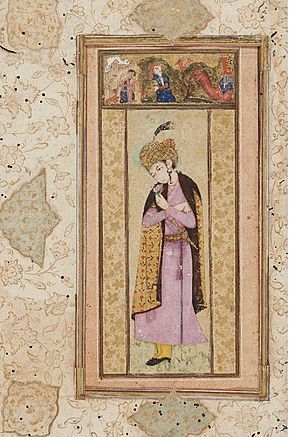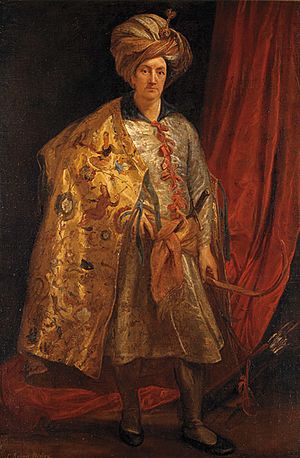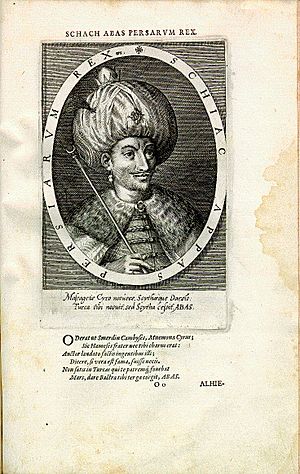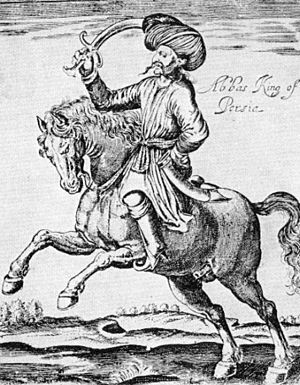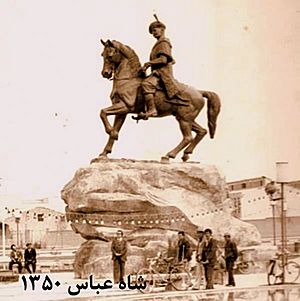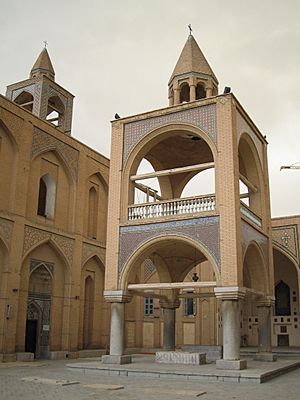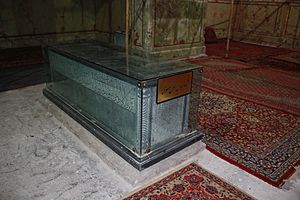Abbas the Great facts for kids
Quick facts for kids Abbas the Great |
|||||
|---|---|---|---|---|---|
| Šāhānšāh-ī Īrān (King of Kings of Iran) Zell'ollāh (Shadow of God) Ṣāḥebqerān-ī-ʿAlāʾ (Supreme Lord of the Auspicious Conjunction) |
|||||
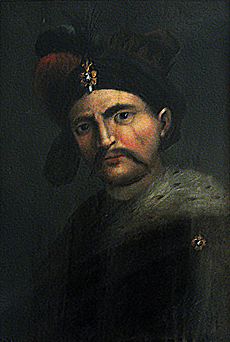
Abbas in a 16th or 17th century portrait
|
|||||
| Shah of Iran | |||||
| Reign | 1 October 1588 – 19 January 1629 | ||||
| Coronation | 1588 | ||||
| Predecessor | Mohammad Khodabanda | ||||
| Successor | Safi | ||||
| Born | 27 January 1571 Herat, Safavid Iran (modern-day Afghanistan) |
||||
| Died | 19 January 1629 (aged 57) Mazandaran, Safavid Iran |
||||
| Burial | Mausoleum of Shah Abbas I, Kashan, Iran | ||||
| Consort |
|
||||
| Issue | See below | ||||
|
|||||
| Dynasty | Safavid | ||||
| Father | Mohammad Khodabanda | ||||
| Mother | Khayr al-Nisa Begum | ||||
| Religion | Shia Islam | ||||
Abbas I (Persian: عباس یکم; 27 January 1571 – 19 January 1629), also known as Abbas the Great (Persian: شاه عباس بزرگ, romanized: Šāh ʿAbbās-e Bozorg), was the fifth shah (king) of Safavid Iran. He ruled from 1588 to 1629. Abbas was the third son of Shah Mohammad Khodabanda. Many people consider him one of the greatest rulers in Iranian history and of the Safavid dynasty.
Abbas became king during a difficult time for Iran. His father's rule was weak. The country faced many disagreements among the different groups of the Qizilbash army. These conflicts led to the death of Abbas' mother and older brother. Meanwhile, Iran's enemies, the Ottoman Empire and the Uzbeks, took advantage of this chaos. They seized parts of Iranian land. In 1588, a Qizilbash leader named Murshid Qoli Khan overthrew Shah Mohammad. He placed 16-year-old Abbas on the throne. However, Abbas quickly took full power for himself.
Under his rule, Iran created a new system using "ghilman" soldiers. These were thousands of Circassian, Georgian, and Armenian slave-soldiers. They joined the government and the army. Abbas used these new groups to reduce the power of the Qizilbash. He also reformed the Iranian army. These changes helped him fight the Ottomans and Uzbeks. He was able to win back lost provinces, including Kakheti. Many people from Kakheti were moved from their homes. By the end of the 1603–1618 Ottoman War, Abbas had regained control over Transcaucasia and Dagestan. He also took back parts of Eastern Anatolia and Mesopotamia. He recovered land from the Portuguese and the Mughals. He also expanded Iran's influence in the North Caucasus.
Abbas was a great builder. He moved his kingdom's capital from Qazvin to Isfahan. He made Isfahan a beautiful city known for its Safavid architecture. In his later years, Abbas became suspicious of his own sons. This was due to court intrigues. His sons faced harsh fates, some were killed or blinded.
Contents
Early Life and Challenges
Abbas was born on January 27, 1571, in Herat. He was the third son of Mohammad Khodabanda and his wife, Khayr al-Nisa Begum. His father was the first son of Tahmasp I, the second Safavid Shah. Abbas' father, Mohammad Khodabanda, was the governor of Herat. This city was the capital of the large province of Khorasan. Mohammad Khodabanda could not become king because an eye disease left him almost blind.
When Abbas was very young, he was separated from his parents. His father and mother moved to govern Shiraz. Abbas was made the official governor of Herat. He was still a baby at the time. Shah Qoli Sultan Ustajlu, a leader from the Qizilbash Ustajlu tribe, became his guardian. Abbas learned important soldier skills from his Qizilbash guardians. He played polo and often went hunting. Like many Iranian kings, he loved hunting. It was seen as a way to train for the military. Abbas grew up with household "slaves" or ghulams. These were his childhood friends. Many of them were likely Georgians, Armenians, or Circassians.
In 1576, Tahmasp I died without choosing an heir. This led to a civil war. At first, Tahmasp's favorite son, Haydar Mirza Safavi, became king. But he was soon overthrown. After his death, Ismail II was crowned king. He had been imprisoned for twenty years. This made him very paranoid. He saw enemies everywhere. He began to eliminate many people, especially from the Ustajlu tribe. Young Abbas was affected when his guardian, Shah Qoli Sultan, was killed.
Ismail then turned to his family. He ordered the execution of many half-brothers, cousins, and nephews. He spared Mohammad Khodabanda. This was possibly because they were full brothers. Also, Mohammad Khodabanda was blind and could not claim the throne. In November 1577, Ismail sent Ali-Qoli Khan Shamlu to Herat to kill young Abbas. Ali-Qoli delayed the execution. He said it was not right to kill an "innocent" descendant of a seyed on holy days. This delay saved Abbas' life. On November 24, Ismail II died from poison. Ali-Qoli Khan then became the governor of Herat and Abbas' new guardian.
On February 11 or 13, 1577, the Qizilbash chose Mohammad Khodabanda as the new shah. The new shah seemed weak and uninterested. Power soon went to others. Abbas' mother, Khayr al-Nisa Begum, was a strong woman. She took charge of the government. She made all the decisions, even in military matters. The Qizilbash were not happy with her power. Divisions in the Safavid court led to rebellions. Old Qizilbash rivalries started again. The Ustajlu and Shamlu tribes fought each other.
The weak state of the country led the Ottoman Empire to declare war against Iran in 1578. The Safavid armies lost several battles. Khayr al-Nisa Begum tried to fight back. She led an army north with her son, Hamza Mirza. But her attempts to control the war angered the Qizilbash leaders. On July 26, 1579, the Qizilbash stormed her home and killed her. Abbas was still a boy. He barely knew his mother. But her murder by the Qizilbash deeply affected him. From that time, he likely believed that the Qizilbash's power had to be broken.
Becoming the Shah
After his mother's death, Hamza Mirza, aged eleven, became the crown prince. The Qizilbash felt they had nothing to fear from a child. They took ultimate power and fought among themselves. The conflict was strongest in Qazvin and Khorasan. Ali-Qoli Khan Shamlu and Murshid Qoli Khan Ustajlu fought against the Turkman governor of Mashhad. The Takkalu tribe took power in Qazvin. They removed many important Shamlu members. This angered Ali-Qoli Khan. As the queen had predicted, in 1581, he rebelled. He made ten-year-old Abbas the leader of a rebellion in Khorasan. He declared Abbas the Shah of Iran. Ali-Qoli and Murshid Qoli Khan took control of Nishapur. They made coins and read prayers in Abbas' name.
The next year, an army from Western Iran went to Khorasan. They tried to end the rebellion. They attacked Torbat-e Heydarieh and Herat. Both attempts failed. When they heard about another Ottoman attack, the ministers made a deal with Ali-Qoli Khan. He faced no punishment. He only had to promise loyalty to Hamza Mirza as the next king. He remained governor and Abbas' guardian. He even received a reward from the shah. Many people began to believe Abbas Mirza would eventually become king.
Meanwhile, Hamza Mirza was busy fighting the Ottomans in Tabriz. But he got caught in rivalries between Qizilbash tribes. He angered his officers by executing the Qizilbash governor of Azerbaijan. So, on December 5, 1586, his personal barber assassinated him. This opened the way for Abbas to become king.

In Khorasan, Murshid Qoli Khan became a rival to Ali-Qoli. He took Mashhad and took Abbas from Ali-Qoli. An Uzbek invasion threatened Herat. Murshid Qoli realized this was his last chance to make Abbas king. Many Qizilbash leaders promised to support Abbas. Murshid Qoli Khan decided to act. On a September day in 1587, Abbas and his guardian rode towards Qazvin. They had a small group of horsemen. As they rode, more Qizilbash leaders pledged their loyalty. By the time they reached Qazvin, their group had grown to 2,000 horsemen. The people of Qazvin supported Abbas. He rode into the capital with Murshid Qoli Khan.
Mohammad Khodabanda and his heir, Abu Taleb Mirza, were in Qom. When they heard the news, their leaders abandoned them for Abbas Mirza. Mohammad Khodabanda had no choice but to give up his throne. On October 1, 1588, in Qazvin, he placed his crown on his seventeen-year-old son's head. Abbas became Shah Abbas I. Murshid Qoli Khan, who helped Abbas become king, was rewarded with the title of vakil (viceroy).
Abbas Takes Control
The kingdom Abbas inherited was in a very bad state. The Ottomans had taken huge areas in the west and north-west. This included the important city of Tabriz. The Uzbeks had taken half of Khorasan in the north-east. Iran itself was torn apart by fighting among different Qizilbash groups. They had even killed the queen in 1579.
First, Abbas dealt with those who killed his mother. He executed three of the main leaders. He exiled four others. His next goal was to free himself from Murshid Qoli Khan's power. Murshid made Abbas marry Hamza's widow. He also started giving important government jobs to his own friends. He slowly kept Abbas confined to the palace. Meanwhile, the Uzbeks continued to conquer Khorasan. When Abbas heard they were attacking his old friend Ali Qoli Khan Shamlu in Herat, he begged Murshid to act. Murshid feared a rival. He did nothing until news came that Herat had fallen. The Uzbeks had killed many people there. Only then did he start a campaign to Khorasan. But Abbas planned to get revenge for Ali Qoli Khan's death. He arranged for four Qizilbash leaders to kill Murshid after a banquet on July 23, 1589. With Murshid gone, Abbas could now rule Iran on his own.
Abbas decided he had to bring order back to Iran. Only then would he fight foreign invaders. To do this, he signed a peace treaty with the Ottomans in 1590. This was known as the Treaty of Istanbul. He gave them the provinces of Azerbaijan, Karabagh, Ganja, Dagestan, and Qarajadagh. He also gave parts of Georgia, Luristan, and Kurdistan. This treaty even gave the former capital of Tabriz to the Ottomans.
Reducing Qizilbash Power
The Qizilbash had been the main force of the Safavid army from the beginning. They also held many government jobs. This meant that the Qizilbash held most of the power. The shah often had little power. To balance their power, Abbas turned to a new group in Iranian society. These were the ghulams (meaning "slaves"). Shah Tahmasp I had started this idea. Abbas created a new army force from these slaves. It had up to 37,000 soldiers. The king fully paid for this army. This greatly weakened the Qizilbash's power. They no longer had a "military monopoly" in Persia.
Like the janissaries of the Ottoman Empire, these ghulams were mainly Georgians, Circassians, and Armenians. They had been brought to Iran. They converted to Islam. They served in the army, royal household, or government. They were loyal only to the shah. Under Abbas, this new group grew in power. Thousands of ethnic Georgians, Circassians, and Armenians became important parts of Iranian society. They took key government, royal household, and military jobs.
Tahmasp I, Abbas' grandfather, had realized that he faced threats from rival groups. These rivalries could harm the ruler. For Tahmasp, the problem was with the Qizilbash military leaders. They believed that being close to a Safavid family member brought them power and wealth.
So, between 1540 and 1555, Tahmasp invaded the Caucasus region several times. This gave his soldiers battle experience. It also led to the capture of many Christian Circassian and Georgian slaves. These slaves formed the base of a Safavid military slave system. They served a similar role to the janissaries of the Ottoman Empire. Their arrival in large numbers created a new group in Iranian society. This group was made up only of ethnic Caucasians. Even though the first slave soldiers were not organized until Abbas' rule, Caucasians became important in the royal household and government during Tahmasp's time.

Abbas learned from his grandfather. He had been used by fighting Qizilbash groups when he was young. So, he decided to support this new (Caucasian) group. He knew he had to control the Qizilbash. Abbas strongly encouraged the growth of this new group. It was also called the third force. It is thought that during Abbas' reign, about 130,000 to 200,000 Georgians, tens of thousands of Circassians, and around 300,000 Armenians were moved from the Caucasus to Persia. Many of them gained important jobs in Iranian society. This included high government positions and the ghulam corps. Many of those moved from the Caucasus settled in different parts of Iran. They became craftsmen, farmers, traders, soldiers, and governors.
As part of the ghulam system, Abbas greatly expanded the ghulam military corps. It grew from a few hundred during Tahmasp's time to 15,000 highly trained cavalrymen. This was part of a larger army division of 40,000 Caucasian ghulams. Abbas then reduced the number of Qizilbash governors. He moved them to other areas. This broke their ties with local communities and reduced their power. Most were replaced by ghulams, who were loyal to the shah.
By 1595, Allahverdi Khan, a Georgian, became one of the most powerful men in the Safavid state. He was made Governor-General of Fars, one of Persia's richest provinces. His power peaked in 1598. He became the commander-in-chief of all armed forces. The ghulam system helped the shah control the rival Qizilbash Turks and Persians. It also solved money problems. The shah now had full control of the provinces. Their income went directly to the royal treasury. In the royal household, Circassians and Georgians quickly replaced the Turcoman groups. They gained direct influence in the Safavid government and court.
The growing number of Georgians and Circassians in the Safavid government competed with the Qizilbash for power. This led to court intrigues. This competition increased under Abbas and his successors. It weakened the dynasty. Abbas' own son and crown prince, Mohammad Baqer Mirza, was caught in court intrigues. This led to his execution under Abbas' orders.
Reforming the Army
Abbas needed ten years to make his army strong. This was so he could fight his Ottoman and Uzbek enemies. During this time, the Uzbeks and Ottomans took much land from Iran. He also used military changes to sideline the Qizilbash. He created a standing army of thousands of ghulams. These were always recruited from ethnic Georgians and Circassians. To a lesser extent, Iranians also joined. This new army fought alongside the traditional Qizilbash forces. The new army regiments were loyal to the Shah. The new army had 10,000 to 15,000 cavalry (Caucasian ghulams) with muskets. It also had 12,000 musketeers and 12,000 artillery soldiers. Abbas also increased his personal bodyguard, made of Caucasian ghulams, to 3,000. This force totaled about 40,000 soldiers. The Shah paid for them.
Abbas greatly increased the number of cannons he had. He could use 500 cannons in one battle. Strict discipline was enforced. Looting was severely punished. Abbas also got military advice from European visitors. These included the English adventurers Sir Anthony Shirley and his brother Robert Shirley. They arrived in 1598. They were on a mission to persuade Persia to join an alliance against the Ottomans.
From 1600 onwards, the Safavid leader Allahverdi Khan, with Robert Shirley, further reorganized the army. This led to an increase in the number of ghulams to 25,000.
Consolidating the Empire
During the 1590s, Abbas began to remove provincial rulers in Persia. He started with Khan Ahmad Khan, the ruler of Gilan. Khan Ahmad Khan had refused Abbas' request for his daughter, Yakhan Begum, to marry Abbas' son. This led to a Safavid invasion of Gilan in 1591. In 1593–94, Jahangir III, the ruler of Nur, gave his lands to Abbas. In 1597, Abbas removed the ruler of Lar. One year later, Jahangir IV, the ruler of Kojur, killed two Safavid nobles. In response, Abbas invaded his lands in 1598. Jahangir escaped but was later captured and killed.
Winning Back Lost Lands
War Against the Uzbeks
Abbas' first campaign with his new army was against the Uzbeks. They had taken Khorasan and were causing much damage. In April 1598, he attacked. One of the main cities, Mashhad, was easily retaken. But the Uzbek leader, Din Mohammed Khan, was safe behind the walls of Herat. Abbas tricked the Uzbek army out of the city by pretending to retreat. A fierce battle happened on August 9, 1598. The Uzbek khan was wounded. His troops retreated. The khan was later killed by his own men. During the battle, Farhad Khan had fled. He was accused of being a coward. But Abbas forgave him. He wanted to make him governor of Herat, but Farhad Khan refused. This made Abbas feel insulted. Farhad Khan's arrogant behavior and suspected betrayal made him a threat. So Abbas had him executed. Abbas then made Gilan and Mazandaran royal lands. He appointed Allahverdi Khan as the new commander-in-chief of the Safavid army.
By 1599, Abbas had conquered Herat and Mashhad. He had also moved as far east as Balkh. This victory was short-lived. He would later only control some of these lands. The new ruler of the Khanate of Khiva, Baqi Muhammad Khan, tried to retake Balkh. Abbas found his troops were still not strong enough against the Uzbeks. By 1603, the borders were stable. Abbas held most of Khorassan, including Herat, Sabzevar, Farah, and Nisa.
Abbas' north-east border was now safe. He could turn his attention to the Ottomans in the west. After defeating the Uzbeks, he moved his capital from Qazvin to Isfahan.
War Against the Ottomans
The Safavids had not yet defeated their main rival, the Ottomans, in battle. After some arrogant demands from the Ottoman ambassador, the Shah had him seized. He had his beard shaved and sent it to the sultan. This was a declaration of war. In the conflict, Abbas first recaptured Nahavand. He destroyed the fortress there. The Ottomans had planned to use it as a base for attacks on Iran. The next year, Abbas pretended he was going on a hunting trip to Mazandaran. This was a trick to fool Ottoman spies. His real target was Azerbaijan. He changed course for Qazvin. There, he gathered a large army. He set off to retake Tabriz, which the Ottomans had held for some time.
For the first time, the Iranians used their artillery effectively. The town, which had been ruined by Ottoman rule, soon fell. Abbas then attacked Yerevan. This town had become a main Ottoman stronghold in the Caucasus. It fell in June 1604. With it, the Ottomans lost the support of most Armenians, Georgians, and other Caucasians. Abbas was unsure how the new Sultan Ahmed I would react. He pulled back from the region, using scorched earth tactics. For a year, neither side moved. But in 1605, Abbas sent his general Allahverdi Khan to meet Ottoman forces near Lake Van. On November 6, 1605, the Iranians, led by Abbas, won a major victory over the Ottomans at Sufiyan, near Tabriz. In the Caucasus, Abbas also captured what is now Kabardino-Balkaria. The Persian victory was recognized in the Treaty of Nasuh Pasha in 1612. This gave them back control over most of the Caucasus.
Several years of peace followed. The Ottomans carefully planned their next move. But Iranian spies watched their secret training. Abbas learned that the Ottoman plan was to invade Iran through Azerbaijan. They would take Tabriz, then move to Ardabil and Qazvin. They would use these cities to bargain for other lands. The shah decided to set a trap. He would let the Ottomans enter the country, then destroy them. He had Tabriz emptied of its people. He waited at Ardabil with his army. In 1618, an Ottoman army of 100,000 invaded. They easily took Tabriz. The Ottoman leader sent an ambassador to the shah. He demanded peace and the return of lands taken since 1602. Abbas refused. He pretended he was ready to burn Ardabil and retreat further inland. When the Ottoman leader heard this, he decided to march on Ardabil right away. This was exactly what Abbas wanted. His army of 40,000 was hiding. They ambushed the Ottoman army. The battle ended in a complete victory for the Iranians.
In 1623, Abbas decided to take back Mesopotamia. His grandfather Tahmasp had lost it. Abbas took advantage of the confusion around the new Ottoman Sultan Murad IV. He pretended to go on a pilgrimage to Shi'ite holy sites. But he used his army to seize Baghdad. However, Abbas was then busy with a rebellion in Georgia in 1624. This allowed an Ottoman force to attack Baghdad. But the Shah came to its rescue the next year. He crushed the Turkish army. In 1638, after Abbas' death, the Ottomans retook Baghdad. The Iranian–Ottoman border was then set. It is roughly the same as the current Iran–Turkey and Iran–Iraq borders.
Stopping Georgian Uprisings
Between 1614 and 1616, during the Ottoman–Safavid War, Abbas stopped a rebellion. It was led by his formerly loyal Georgian subjects Luarsab II and Teimuraz I.
In 1606, Abbas had made these Georgians kings of Kartli and Kakheti. They were Safavid vassal states. Tensions soon grew between the Shah and the Georgian kings. In 1613, the Shah called them to join him on a hunting trip. They did not come. They feared they would be imprisoned or killed. War broke out. Iranian armies invaded in March 1614. The two allied kings fled to the Ottoman vassal Imeretia. Abbas was very angry. He saw it as a betrayal. He moved 30,000 Kakhetian farmers to Iran. He appointed a grandson of Alexander II of Imereti to the throne of Kartli. This was Jesse of Kakheti (also known as "Isā Khān"). He was raised in Isfahan and was a Muslim. He was seen as fully loyal to the Shah.
Abbas threatened Imeretia if they did not give up the kings. The Imeretian rulers refused. Luarsab, however, surrendered to the Shah. Abbas treated him well at first. But then he learned that Luarsab and Teimuraz had offered an alliance with the Ottomans. He demanded that Luarsab accept Islam. When Luarsab refused, he was put in prison.
Teimuraz returned to eastern Georgia in 1615. He took advantage of renewed fighting between the Ottomans and Safavids. He defeated a Safavid force. But the Ottoman army delayed its invasion. Abbas was able to send an army back to defeat Teimuraz. He then increased his invasion after making a truce with the Ottomans. Iranian rule was fully restored over eastern Georgia. In a punishment trip to Kakhetia, his army killed perhaps 60,000–70,000 Georgians. Twice as many were moved to Iran. This removed about two-thirds of the Kakhetian population. More people were rounded up in 1617. In 1619, Abbas appointed Simon II as a puppet ruler of Kakheti. He placed his own governors over rebellious districts.
Abbas secured the region for a time. He then took more revenge on Teimuraz and Luarsab. He eliminated Teimuraz's sons. He executed Luarsab in 1622. In 1624, he had Ketevan killed when she refused to give up Christianity. Teimuraz sought help from the Ottomans and Russia.
Abbas was warned of another Kakhetian uprising. He returned to Georgia in early 1625. He tricked Kakhetian soldiers and began executing them. He also planned to execute all armed Kartlians, including his general Giorgi Saakadze. However, Saakadze found out about the plot. Saakadze then joined the Georgians. He led a new rebellion. It succeeded in driving the Persians out of Kartli and Kakheti. Teimuraz was crowned king of both territories. Abbas counterattacked in June. He won the war and dethroned Teimuraz. But he lost half his army to the Georgians. He was forced to accept Kartli and Kakheti as vassal states. He abandoned his plans to remove Christians from the area.
Even then, Saakadze and Teimuraz started another rebellion in 1626. They cleared Iranian forces from most of the region. The Georgian territories continued to resist Safavid attacks until Abbas' death.
Kandahar and the Mughals
The Safavids were usually allies with the Mughals in India. They were against the Uzbeks, who wanted the province of Khorasan. The Mughal emperor Humayun had given Abbas' grandfather, Shah Tahmasp, the province of Kandahar. This was a reward for helping him regain his throne. In 1590, Akbar, Humayun's successor, took Kandahar. Abbas kept friendly relations with the Mughals. But he still wanted Kandahar back. Finally, in 1620, a diplomatic incident led to war. The Iranian ambassador refused to bow to Emperor Jahangir. India was in civil unrest. Abbas realized he only needed a quick attack to take back Kandahar in 1622.
After the conquest, he was very friendly to Jahangir. He claimed he had only taken back what was rightfully his. He said he had no more territorial ambitions. Jahangir was not happy. But he could not recapture the province. A childhood friend of Abbas, Ganj Ali Khan, was made governor of the city. He ruled until his death in 1624/5.
War Against the Portuguese
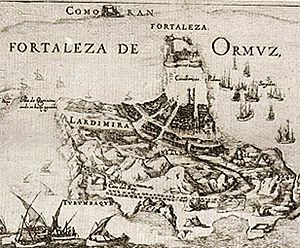
During the 16th century, the Portuguese had set up bases in the Persian Gulf. In 1602, the Iranian army, led by Imam Quli Khan, drove the Portuguese from Bahrain. In 1622, with help from four English ships, Abbas retook Hormuz from the Portuguese. He replaced it with a new port, Bandar Abbas, nearby on the mainland. But it never became as successful.
Shah and His People
Isfahan: A New Capital
Abbas moved his capital from Qazvin to the more central city of Isfahan in 1598. He made Isfahan beautiful with new mosques, baths, colleges, and inns. Isfahan became one of the most beautiful cities in the world. As Roger Savory writes, "Not since the development of Baghdad in the eighth century A.D. by the Caliph al-Mansur had there been such a comprehensive example of town-planning in the Islamic world." Isfahan became the center of Safavid architecture. It featured the Masjed-e Shah and the Masjed-e Sheykh Lotfollah. Other monuments included the Ali Qapu, the Chehel Sotoun palace, and the Naghsh-i Jahan Square.
Abbas used the Armenian people to make Isfahan the center of the Safavid Empire. He had forcibly moved them to Isfahan from their Armenian homelands. Once they settled, he gave them much freedom. He encouraged them to continue their silk trade. Silk was a key part of the economy. It was seen as the best form of money. The Armenians already had trade networks. This helped Abbas strengthen Iran's economy.
Arts and Culture
Abbas' painting studios in Isfahan created some of the finest art in modern Iranian history. Famous painters like Reza Abbasi and Muhammad Qasim worked there. Despite the Safavid dynasty's religious roots, the art of Abbas' time showed a certain relaxation of strict rules. Abbas brought 300 Chinese potters to Iran. This was to improve local production of Chinese-style ceramics.
Under Abbas' rule, carpet weaving became an important part of Persian industry and culture. Wealthy Europeans started buying Persian rugs. Silk production became a royal monopoly. Manuscripts, bookbinding, and ceramics were also important exports.
Attitude Towards Religious Minorities
Like almost all other Safavid monarchs, Abbas was a Shi'ite Muslim. He especially respected Imam Hussein. In 1601, he walked from Isfahan to Mashhad. This was to visit the shrine of Imam Reza. He restored the shrine, which the Uzbeks had damaged. Sunni Islam was the religion of Iran's main rival, the Ottoman Empire. So Abbas often treated Sunnis living in western border provinces harshly.
Abbas was usually tolerant of Christians. The Italian traveler Pietro della Valle was amazed at the Shah's knowledge of Christian history and beliefs. Building diplomatic ties with European Christian states was a key part of the shah's foreign policy. Christian Armenia was a key Safavid province next to the Ottoman Empire. From 1604, Abbas used a "scorched earth" policy there. This was to protect his north-western border from Ottoman forces. This policy involved moving up to 300,000 Armenians from their homes. The Armenians mainly came from the rich merchant town of Jugha (also known as Jolfa). Many were moved to New Julfa. This was a town the shah built for Armenians near his capital Isfahan. Thousands of Armenians died on the journey. Those who survived had much religious freedom in New Julfa. The shah built them a new cathedral. Abbas wanted to boost the Iranian economy. He encouraged the Armenian merchants who moved to New Julfa. Besides religious freedom, he offered them interest-free loans. He also allowed the town to elect its own mayor. Other Armenians were moved to the provinces of Gilan and Mazandaran. They were less lucky. Abbas wanted to build a second capital in Mazandaran, Farahabad. But the climate was unhealthy. Many settlers died. Others slowly left the city.
Abbas was less tolerant of Christians in Georgia. The threat of rebellion was greater there. Abbas often demanded that nobles convert to Shia Islam. He had Ketevan the Martyr killed when she refused. Abbas' anger at Georgian rebellions also led to his plan to move or eliminate eastern Georgia's Christians. He wanted to replace them with Turkmens.
Contacts with Europe
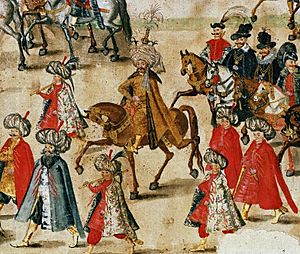
Abbas' tolerance towards most Christians was part of his plan. He wanted to build diplomatic links with European powers. He hoped to get their help against their common enemy, the Ottoman Empire. The idea of such an alliance was not new. Over a century before, Uzun Hassan, a ruler in Iran, had asked the Venetians for military help. But no Safavid ruler had made diplomatic moves to Europe before. Abbas' attitude was very different from his grandfather, Tahmasp I. Tahmasp I had expelled the English traveler Anthony Jenkinson from his court because he was a Christian. Abbas, for his part, said he "preferred the dust from the shoe soles of the lowest Christian to the highest Ottoman personage."
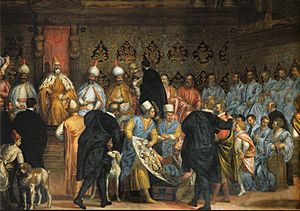
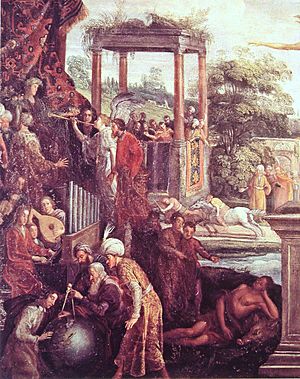
In 1599, Abbas sent his first diplomatic mission to Europe. The group crossed the Caspian Sea. They spent the winter in Moscow. Then they went through Norway and Germany. There, Emperor Rudolf II received them. They finally arrived in Rome. Pope Clement VIII gave them a long meeting. They reached the court of Philip III of Spain in 1602. The expedition never returned to Iran. Their ship was wrecked while sailing around Africa. But it marked an important new step in contacts between Iran and Europe. Europeans became fascinated by Iranians and their culture. For example, Shakespeare's 1601–02 Twelfth Night mentions 'the Sophy' twice. This was the English term for the Shahs of Iran. Persian fashions, like shoes with heels for men, were eagerly adopted by European nobles. From then on, the number of diplomatic missions greatly increased.
The shah had hoped for an alliance with Spain. Spain was the main opponent of the Ottomans in Europe. Abbas offered trading rights and the chance to preach Christianity in Iran. In return, he wanted help against the Ottomans. But the issue of Hormuz remained. This port had fallen into Spanish hands in 1580. The Spanish demanded Abbas break ties with the English East India Company. Only then would they consider giving up the town. Abbas could not agree. Eventually, Abbas became frustrated with Spain. He also felt this way about the Holy Roman Empire. They wanted his 400,000+ Armenian subjects to swear loyalty to the Pope. But they did not tell the shah when the Emperor Rudolf signed a peace treaty with the Ottomans. Contacts with the Pope, Poland, and Muscovy were also not very successful.
More came from Abbas' contacts with the English. However, England had little interest in fighting the Ottomans. The Shirley brothers arrived in 1598. They helped reorganize the Iranian army. This was crucial for the Safavid victory in the Ottoman-Safavid War (1603–1618). It was the first Safavid victory in battle over their Ottoman rivals. One of the Shirley brothers, Robert Shirley, led Abbas' second diplomatic mission to Europe from 1609 to 1615. The English East India Company also became interested in Iran. In 1622, four of its ships helped Abbas retake Hormuz from the Portuguese. Taking Hormuz gave the Company a chance to trade with Persia. They tried to trade English cloth for silk. But this was not very profitable due to low Persian interest.
Later Years and Death
Abbas had five sons. Three of them lived past childhood. So, the Safavid succession seemed secure. He had a good relationship with the crown prince, Mohammed Baqir Mirza (born 1587). However, in 1614, during a campaign in Georgia, the shah heard rumors. He heard that the prince was plotting against him with a leading Circassian. Soon after, Mohammed Baqir broke a rule during a hunt. He killed a boar before the shah could. This seemed to confirm Abbas' suspicions. He became sad and no longer trusted any of his three sons. In 1615, he decided he had to have Mohammed killed. A Circassian carried out the Shah's orders. The prince was murdered in a bathhouse. The shah almost immediately regretted his action. He was filled with grief.
In 1621, Abbas became very ill. His heir, Mohammed Khodabanda, thought he was dying. He began to celebrate becoming king with his Qizilbash supporters. But the shah recovered. He punished his son by blinding him. This would prevent him from ever taking the throne. The blinding was only partly successful. The prince's followers planned to sneak him out of the country. They wanted to take him to the Mughals for help. They would then overthrow Abbas and put Mohammed on the throne. But the plot was discovered. The prince's followers were executed. The prince himself was imprisoned. He was later murdered by Abbas' successor, Shah Safi.
Imam Qoli Mirza, the third and last son, then became the crown prince. Abbas prepared him carefully for the throne. But for some reason, in 1627, he had him partly blinded. He was also imprisoned.
Unexpectedly, Abbas then chose his grandson, Sam Mirza, as his heir. Sam Mirza was the son of Mohammed Baqir Mirza. He was said to dislike his grandfather because of his father's murder. Nevertheless, he became Shah Safi at age 17 in 1629. Abbas' health was poor from 1621 onwards. He died at his palace in Farahabad on the Caspian coast in 1629. He was buried in Kashan.
Abbas' Character and Legacy
According to Roger Savory, Shah Abbas I had many qualities that earned him the title 'the Great'. He was a brilliant military leader. He preferred to achieve his goals through diplomacy rather than war. He showed great patience. In Michael Axworthy's view, Abbas "was a talented administrator and military leader, and a ruthless autocrat." His rule was the most creative period of the Safavid era. But the civil wars and troubles of his childhood left him with a dark side of suspicion and brutality. Donald Rayfield described him as "exceptionally smart and active," but also "a murderous paranoiac when angered."
The Cambridge History of Iran disagrees that Abbas' death started the decline of the Safavid dynasty. Iran continued to do well throughout the 17th century. But it blames him for the poor leadership of later Safavid shahs. The removal of royal princes, by blinding or keeping them isolated, stopped the training of good successors. This became common practice under Abbas.
Abbas spoke the Turkic language used by the Turkoman part of the Qizilbash. But he was equally comfortable speaking Persian. Persian was the language of government and culture. It was also the language of the court when Isfahan became the capital in 1598. According to García de Silva Figueroa, the Spanish ambassador, Abbas also spoke Georgian. He likely learned it from his Georgian gholams and wives.
Abbas had strong support from common people. He spent much time among them. He personally visited markets and public places in Isfahan. Abbas was short but physically strong until his last years. He could go long periods without sleeping or eating. He could ride long distances. At age 19, Abbas shaved his beard and kept only his mustache. This set a fashion in Iran.
Abbas was also a charming speaker. He could persuade people with his words. The classic Turkmen poet Magtymguly, who lived a century after Abbas, mentioned him in a poem:
- There are many who'd say they are good orators,
- Though nobody is as eloquent as Shah Abbas.
See also
 In Spanish: Abás el Grande para niños
In Spanish: Abás el Grande para niños
- Battle of DimDim
- García de Silva Figueroa
- History of Iran
- Mausoleum of Shah Abbas I
- Persian embassy to Europe (1599–1602)
- Persian embassy to Europe (1609–1615)
- Safavid conversion of Iran from Sunnism to Shiism
- Shah Abbas Mosque, Yerevan
- Shah Abbas Mosque, Ganja




